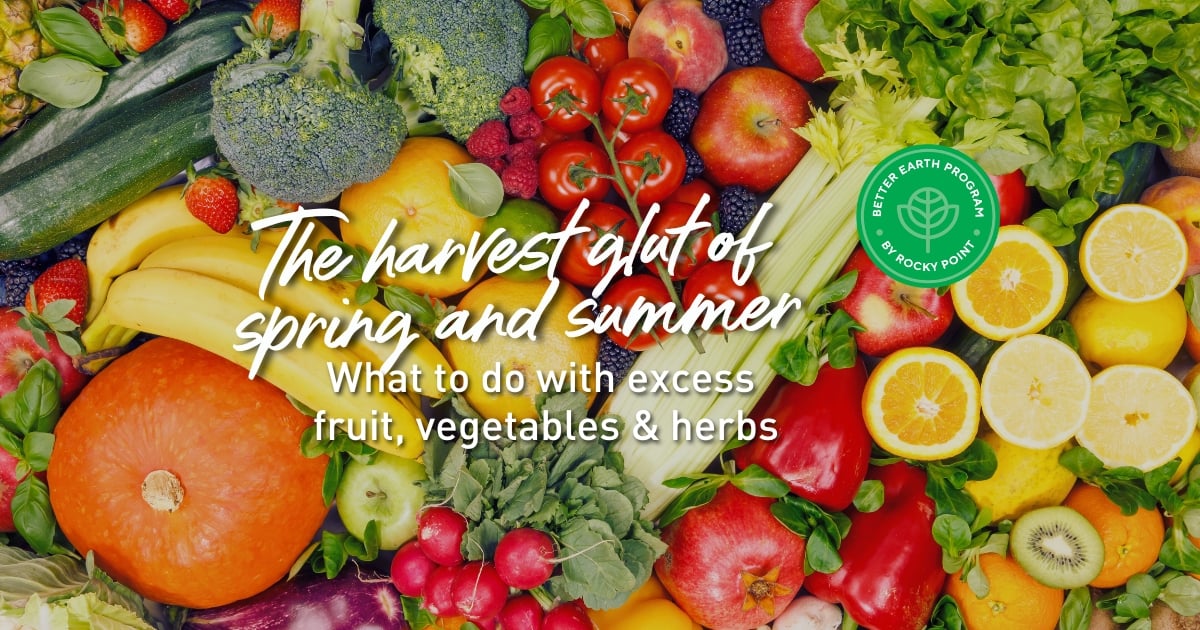Why is it that everything comes to fruition at once? This can be just the nature of a particular crop or fruiting plant, or it can be due to planting excessive amounts of one crop all at the same time.
To avoid the harvest glut there are a couple of things you can do to extend your cropping. Plan by practising successive sowing and planting. This is where you only plant a few seedlings of a particular vegetable or green every 2-3 weeks. With this staggered planting will come staggered crop maturity.
Sometimes even with the best of planning and the glut still occurs what can you do?
Most of your excess fruit, vegetable and herbs will happily be preserved via either;
• Freezing
• Drying or preserving
• Or via some of the tried, true and tested forms of preserving such as jam and jelly making, pickling and chutneys
A lot of herbs and vegetables can also be preserved in oil and vinegar.
You can of course also gift your excess produce to family, friends and neighbours. There are also great community gardens in your local areas where you can learn, grow and share with your local community of gardeners.
The idea of having a big baking or cook-up day is also found rather appealing. Here you would invite a few or many folks over and turn those dozens of zucchinis into zucchini and lime cake, or make jars of chilli and tomato relish, jams galore and have the dehydrator running all the while. The possibilities are endless for a Harvest Day Mash-up at home.
Your guide on what fruits, vegetables and herbs are good to freeze
Freezing is a convenient way to preserve many fruits, vegetables, and herbs, but not all of them freeze well due to differences in texture and water content. Here's a general guide, but keep in mind that individual preferences may vary, and specific preparation methods can influence freezing success.
What fruit, vegetables and herbs freeze well or not so well |
Freeze well | Freeze not so well |
| Fruits that freeze well and not so well |
|
|
| Vegetables that freeze well and not so well |
|
|
| Herbs that freeze well and not so well |
|
|
It's important to note that proper preparation, such as blanching, can improve the freezing success for many vegetables. Additionally, freezing herbs in oil or as part of a sauce (like pesto) can help preserve their flavour and texture. Always label and date your frozen items and use them within a reasonable time for the best quality.
Your guide on what fruits, vegetables and herbs are good for drying or preserving
What fruit, vegetables and herbs Preserve and dry well or not so well |
Preserve and dry well | Challenging to preserve and dry |
| Fruits that preserve and dry well and not so well |
|
|
| Vegetables that preserve and dry well and not so well |
|
|
| Herbs that preserve and dry well and not so well |
|
|
When drying fruits and vegetables, use a dehydrator or your oven on a low setting. For herbs, hang them in bundles in a cool, dry place, or use a dehydrator. Preservation methods may include canning, pickling, or making jams and jellies. Always follow proper guidelines and recipes for safe preservation, and label your items with the date and contents for easy identification.
Fruits, vegetables and herbs that are great for jam and jelly making, pickling and chutneys
Fruits for Jam and Jelly Making:
- Strawberries
- Blueberries
- Raspberries
- Blackberries
- Apricots
- Peaches
- Plums
- Cherries
- Apples
- Grapes
Vegetables for Pickling:
- Cucumbers (for dill pickles)
- Carrots
- Cauliflower
- Green beans
- Jalapeños (for pickled peppers)
- Beets
- Red onions
- Bell peppers
- Asparagus
- Radishes
Herbs for Pickling and Chutneys:
- Dill (for dill pickles)
- Mustard seeds
- Coriander seeds
- Cinnamon sticks
- Cloves
- Ginger
- Garlic
- Turmeric
- Bay leaves
- Tarragon
Fruits and Vegetables for Chutneys:
- Mangoes
- Apples
- Tomatoes
- Onions
- Peppers (bell peppers or chilli peppers)
- Pineapple
- Cranberries
- Raisins
- Plums
- Peaches
_MEB.png?width=842&height=596&name=RP_HorizontalColour(R)_MEB.png)



